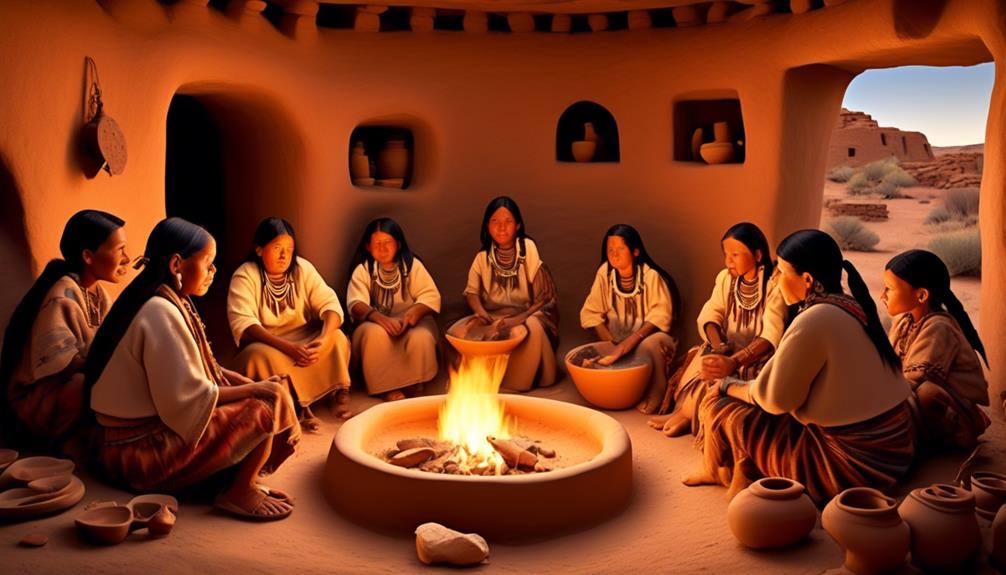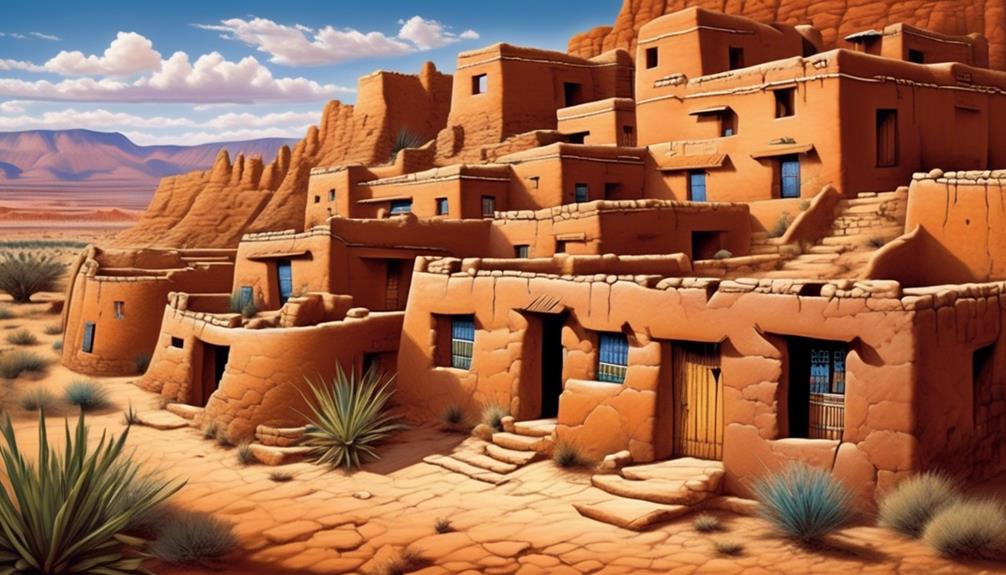When examining the variety of Native American cultures, the Hopi Tribe stands out as a unique and enduring community.
But where exactly are the Hopi Tribe located? The answer to this question not only reveals the physical geography of their ancestral lands but also unveils the profound spiritual and cultural significance that these lands hold for the Hopi people.
As we explore the geographic region of the Hopi Tribe, we will uncover the historical and contemporary layers that make their location more than just a point on a map.
Key Takeaways
- The Hopi Tribe is located in northeastern Arizona, encompassing the three mesas: First Mesa, Second Mesa, and Third Mesa.
- The tribe's territory spans approximately 1.5 million acres and is the defined traditional territory of the Hopi people.
- The land shapes the cultural practices and connection to the land, preserving Hopi ancestral traditions and contributing to their cultural identity.
- The modern-day reservation covers approximately 2,532 square miles and is divided into 12 villages, with initiatives in education, healthcare, and economic development guided by tribal sovereignty.
The Hopi Tribe's Geographic Region
The Hopi Tribe's geographic region is characterized by its stunning desert landscapes and ancient pueblo villages. Situated in the northeastern part of Arizona, the Hopi reservation spans approximately 1.5 million acres, encompassing the three mesas—First Mesa, Second Mesa, and Third Mesa. These geographic boundaries have defined the traditional territory of the Hopi people for countless generations, shaping their cultural practices and connection to the land.
The Hopi people have maintained a deep spiritual and cultural relationship with their traditional territory, which is considered sacred. The landscape not only provides for their physical needs but also serves as the foundation of their beliefs and traditions. This interconnectedness is evident in the agricultural practices, ceremonies, and art forms of the Hopi, all of which are deeply rooted in their geographic region.
Understanding the significance of the Hopi Tribe's geographic boundaries and traditional territory is essential for appreciating the depth of their heritage and the challenges they face in preserving their way of life. By respecting and valuing their land, we honor the Hopi's rich cultural legacy and contribute to the preservation of their ancestral homeland.
Historical Significance of Hopi Lands

Having explored the profound connection between the Hopi Tribe and their traditional territory, we can now examine the historical significance of Hopi lands, shedding light on the enduring impact of their geographic region on their cultural heritage.
- Preservation of Hopi Ancestral Traditions:
The Hopi ancestral lands have been instrumental in preserving the tribe's rich cultural traditions and practices. The unique geographical features and natural resources have shaped the spiritual and agricultural customs of the Hopi people for generations.
- Land Ownership and Sovereignty:
The historical significance of Hopi lands is deeply intertwined with the concept of land ownership and sovereignty. The preservation of their ancestral lands has been crucial in maintaining the tribe's autonomy and self-governance, allowing them to continue their traditional way of life.
- Cultural Identity and Connection to the Land:
The historical significance of Hopi lands extends to the profound cultural identity and spiritual connection that the tribe maintains with their ancestral territory. The land serves as a living link to their history, providing a sense of belonging and continuity for future generations.
The historical significance of Hopi lands encompasses the preservation of ancestral traditions, land ownership and sovereignty, and the deep cultural identity and connection to the land, all of which are integral to the enduring heritage of the Hopi Tribe.
Modern Day Hopi Reservation
Nestled in northeastern Arizona, the modern-day Hopi Reservation encompasses a sprawling expanse of land that serves as the contemporary heart of the Hopi Tribe's cultural and communal life. The Hopi reservation, covering approximately 2,532 square miles, is a sovereign land governed by the Hopi Tribe. The reservation is divided into 12 villages, each with its own distinct history and traditions. The geographic boundaries of the reservation are defined by the natural landscape, including mesas, buttes, and valleys that hold deep spiritual significance for the Hopi people.
The population distribution within the reservation reflects the rich tapestry of the Hopi culture, with community members residing in both traditional earthen homes and modern housing developments. Tribal sovereignty plays a pivotal role in shaping the reservation's governance, enabling the Hopi Tribe to preserve its unique customs and self-determination. Through initiatives in education, healthcare, and economic development, the tribal leadership strives to enhance the well-being of its members while safeguarding the enduring legacy of the Hopi people.
The Hopi reservation stands as a testament to the resilience and enduring spirit of the Hopi Tribe, serving as a living connection to its ancestral lands and traditions.
Cultural and Spiritual Connection to Land

With a deep reverence for our ancestral lands, the Hopi Tribe maintains a profound cultural and spiritual connection to the sprawling expanse of the modern-day Hopi Reservation in northeastern Arizona.
Our cultural preservation is deeply intertwined with the land, as it holds the footprints of our ancestors and the essence of our traditions. This connection isn't merely physical; it's a spiritual bond that's reflected in our daily lives and spiritual practices.
Here are some ways this connection manifests:
- Ceremonial Grounds: The land is the sacred stage for our ceremonial practices, where ancient rites and rituals are performed to honor our heritage and seek blessings for the community.
- *Katsinam*: These sacred spirits are believed to reside within the land, and their presence is essential in our spiritual ceremonies, symbolizing the vital connection between our people and the land.
- *Agricultural Traditions*: Our farming practices aren't only a means of sustenance but are deeply rooted in spiritual significance, reflecting our harmonious relationship with the land and the natural world.
This profound connection to the land is at the heart of our cultural identity, guiding our values, traditions, and spiritual well-being, and it's a legacy we're dedicated to preserving for future generations.
Challenges and Preservation Efforts
Navigating the intricate balance between preserving our cultural and spiritual connection to the land while addressing the challenges posed by modern developments and environmental changes is a task that requires careful consideration and proactive efforts.
The Hopi Tribe faces various challenges in preserving our ancestral lands and traditions. One significant challenge is the encroachment of modern developments, which often threaten the integrity of our sacred sites and disrupt the natural balance of the environment. Additionally, environmental changes, such as climate fluctuations and resource depletion, pose a threat to our traditional way of life and the sustainability of our agricultural practices.
In response to these challenges, the Hopi Tribe has implemented various preservation efforts. We've actively engaged in land conservation initiatives to protect our sacred sites and preserve the natural landscape. Furthermore, we've embraced sustainable practices to mitigate the impact of environmental changes on our agricultural activities.
Through community involvement and partnerships with environmental organizations, we strive to uphold our cultural and spiritual connection to the land while addressing the challenges we face. These preservation efforts are essential in safeguarding our heritage for future generations and ensuring the continuity of our rich traditions.
Frequently Asked Questions
What Are the Traditional Hopi Beliefs and Ceremonies?
We deeply value the Hopi beliefs and their traditional ceremonies. These practices are vital for community preservation and cultural adaptation.
The Hopi people hold sacred the significance of their ceremonies, which are rooted in their connection to the land and their ancestors. These ceremonies serve as a way to maintain their heritage and spiritual connection, fostering a sense of unity and strength within the community.
How Has the Hopi Tribe's Language and Customs Been Impacted by Outside Influences?
In preserving our language, we've faced cultural assimilation. The Hopi tribe's language and customs have been impacted by outside influences, posing challenges for language preservation. Despite this, we hold fast to our traditions and work tirelessly to maintain our unique cultural identity.
Our commitment to preserving our language and customs is unwavering, as we strive to honor our heritage and pass it on to future generations.
What Are the Main Sources of Income for the Hopi Tribe?
Economic activities within the Hopi Tribe are diverse, reflecting our livelihood and cultural preservation. Agriculture, arts and crafts, and tourism are main sources of income. However, external influences have impacted these, as changes in market demand and tourism patterns have affected our traditional practices.
Despite this, we continue to adapt while staying true to our heritage. Our resilience in the face of these challenges is a testament to our commitment to preserving our way of life.
How Has the Hopi Tribe Adapted to Modern Challenges While Preserving Their Cultural Traditions?
In facing modern challenges, the Hopi Tribe has employed various adaptation methods while steadfastly preserving their cultural traditions.
For example, they've integrated sustainable farming practices with modern agricultural techniques to ensure food security while maintaining their deep spiritual connection to the land.
What Are the Main Environmental Concerns Facing the Hopi Tribe's Lands?
Environmental degradation is a significant concern for the Hopi Tribe. Our lands face challenges from factors like mining, climate change, and water scarcity. These issues threaten our cultural and spiritual connection to the land, impacting our ability to practice traditions and sustain our community.
Protecting our lands is crucial for maintaining our tribal sovereignty and preserving our way of life for future generations.
Conclusion
In conclusion, it's quite ironic that the Hopi Tribe, known for their deep connection to the land, is located in an area that has faced numerous challenges and preservation efforts.
Despite the modern day struggles, the historical and spiritual significance of Hopi lands can't be overlooked.
We must continue to support and respect the Hopi Tribe in their efforts to preserve their culture and connection to their ancestral lands.
Mary is a passionate writer who brings creativity and a fresh perspective to our team. Her words have the power to captivate and inspire, making her an essential contributor to our content. Mary’s commitment to storytelling and dedication to promoting Indigenous culture ensures that her work touches the hearts of our readers. We’re fortunate to have her as part of our team.










